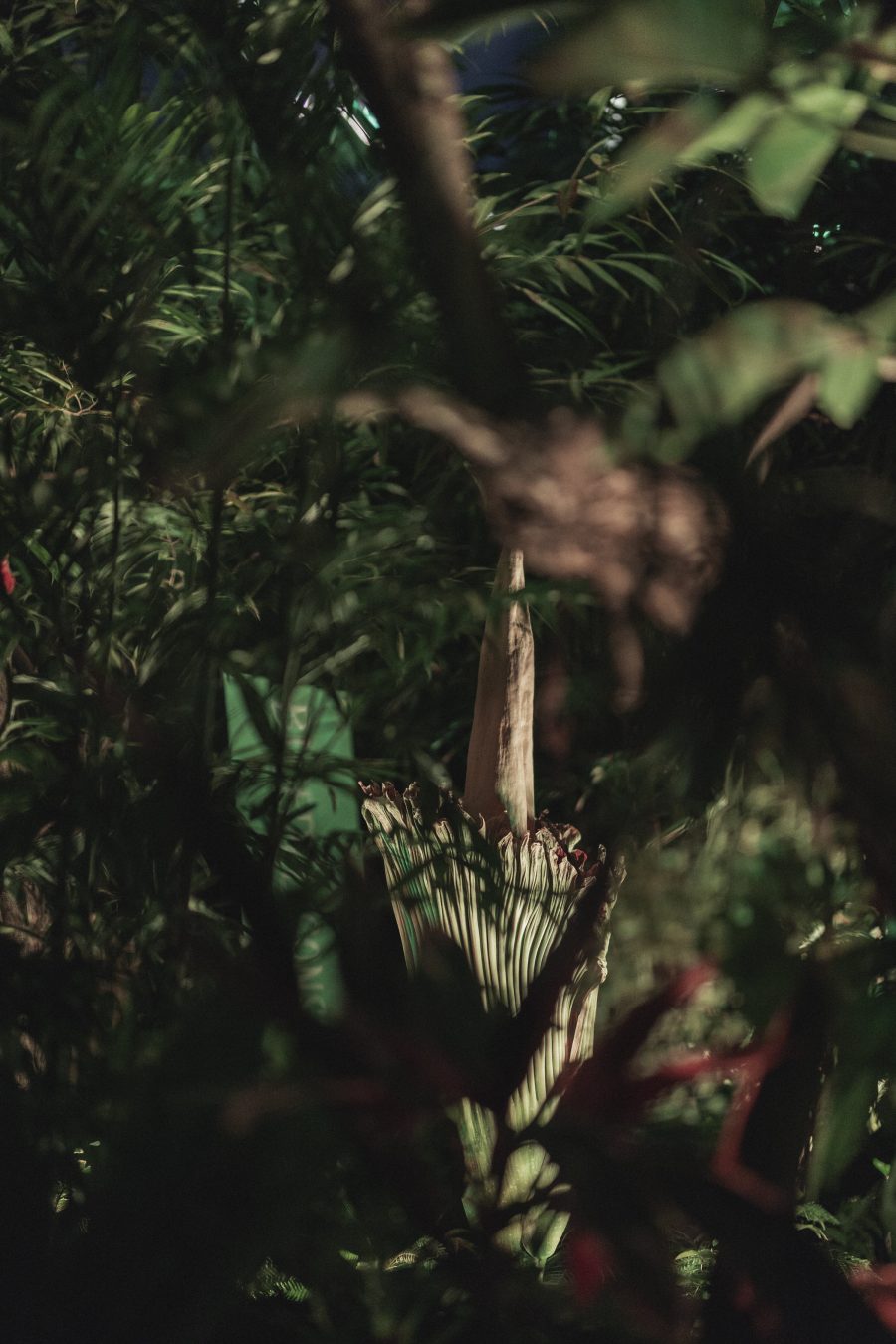Before 8:00 a.m. on a sunny Monday morning, I find myself at the end of a very long line in front of the Bloedel Conservatory in Queen Elizabeth Park. Laden with cameras and buzzing with excitement, hundreds of people have gathered despite the early hour. We are all here with a single, inexplicable purpose: to see—and smell—a gigantic flower that famously reeks of hot garbage and rotten meat. We are here to meet Uncle Fester.
Uncle Fester was the name bestowed, by popular vote, on Vancouver’s corpse flower. The first of its kind to bloom in B.C., the corpse flower became an overnight sensation when the Bloedel announced that it was about to pop, attracting breathless media coverage and clamorous attention on social platforms. For whatever reason, the city has been struck by corpse flower fever. Collectively, we couldn’t wait to get a whiff.
It is a bizarre plant. Like all Uncle Fester fans, I am now intimately familiar with the particulars of the species: it blooms rarely (on average, every seven to 10 years), and for only one or two days. In the weeks before blooming, it grows rapidly; Uncle Fester grew six feet between May and July, sometimes as much as six inches per day. The maturing corpse flower resembles a closed, inverted beach umbrella, to put it demurely; really, there is no confusion about why its Latin name is Amorphophallus titanum, which translates plainly to giant, misshapen phallus. Georgia O’Keeffe would likely blush while painting one.
When a corpse flower blooms, the leafy spathe that envelops the shaft (properly known as the spadix) unfurls to reveal a deep red interior and unleash its ferociously terrible smell in order to attract pollinating insects. The blooming flower is also very hot, the same temperature as blood (98 degrees), which is somehow the most disturbing detail of all.
This is certainly very interesting, even to non-gardeners, but none of it explains why otherwise normal people would line up for hours under the hot July sun to see this plant up close. I certainly can’t explain my own compulsion to check the Bloedel Instagram account 10 times a day, eager for updates. (It’s very obvious when a corpse flower is getting ready to bloom, but the exact timing is impossible to predict.)
Would we love the corpse flower if there were fields of them, blooming for weeks or months like foul roses? Of course not. No one would be excited about a towering, stinking flower if it was as common as an alleyway dumpster. People are susceptible to excitement when it comes to rare, exclusive experiences, and Uncle Fester is more democratic than most. You cannot buy VIP access to it; you can’t plan your schedule around it. All you can do is wait.
Which is what I do under the cloudless summer sky, grateful that I’d remembered to bring a water bottle. Once inside, the conservatory has a clockwise path through its collection of trees and flora, and Uncle Fester is on display near the end. Proceeding slowly, I have time to admire carnivorous pitcher plants (above them is a handwritten sign: do not touch or I will die!), zebra finches, candy-coloured parrots, and towering palms. I wonder how the corpse flower was able to cast such a spell on us when everything else I see seems equally beautiful and improbable.
As the line curves around toward Uncle Fester, cordoned off and surrounded by cameras like Mona Lisa at the Louvre, the pitch of excitement increases. Necks crane around corners, peeking through foliage at the unmistakable silhouette of this giant plant. “I hope it really smells,” someone ahead of me whispers eagerly.
But it doesn’t. The ambient odour of a greenhouse—musty decay and humid earth—is barely accented by the faint scent of a dirty gym bag. It is remarkable all the same, statuesque and alien, revealing its vibrant purple heart; but whatever our expectations and demands, the flower can only offer a glimpse of its biological destiny. And somehow, despite the long wait, the hot day, and the fervent anticipation, that’s enough for me.
After my visit, I look up the nursery where the Bloedel purchased Uncle Fester. “Please,” the website for Raleigh, North Carolina’s Plant Delights advises about Fester’s kin, “do not order this unless you are a passionate and very serious plant NUT!” After a feverish week of thinking about nothing but Amorphophallus titanum, I certainly feel like a serious plant nut. But I quickly realize that I don’t want my own corpse flower. I don’t think anyone really does—there’s no magic in the individual observation. I only want a shared corpse flower, one that belongs to my city and that we named together. I want to simply join in the communal civic experience of suspense and wonder, surrendering to the mystery, the unpredictability.
It might take another decade for Uncle Fester to bloom again, but we’re all in it together. I can wait.
Read more about your Community.










